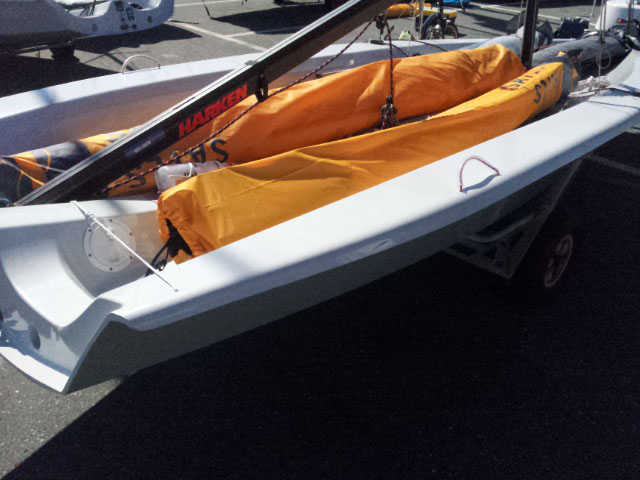
Adam Broughton's Top Tips - Tacking
Tacking RS500 tiller extensions - early boats went out with 1.2m tiller extensions this was quickly changed and they should all now be 1.1m. At this length they should fit past the mainsheet quite easily. It is all about timing! If you are still having problems you can move the mainsheet block on the boom further forwards which will give more space for the tiller extension. You do not want to move it too far forwards as it tends to annoy the crew!
Tacking Medium - High Winds: Helm's Perspective:
-Think you need to tack.
-Look over shoulder to make sure it is clear.
-Call for a tack.
-The crew says ok, then you only start the tack when the crew un cleats the jib.
-As soon as the jib is uncleated, you can start the tack.
- Start pushing the tiller away, make sure there is no/minimum leeward heel. -If you are not over powered pull the main sheet into the centre line as this will help the boat turn and you can use less rudder.
-Push the tiller extension through the gap, up high as there is more space. -Move across boat as boom comes across.
-Switch hands.
-Hike and dump main if you have to.
Crew's Perspective:
-Helm call for a tack.
-Get yourself ready for the tack, raise yourself on trapeze if you need to.
-Hold jib sheet in back hand.
-Only release the jib sheet when you are ready.
-As soon as it is uncleated come straight into the boat. (If you get good you will be able to back the jib coming into the tack even in strong winds. However you still need to uncleat the jib before the helm will tack. Otherwise this will lead to capsizes at points when you can't quite uncleat it).
-Drop old jib sheet.
-Grab jib sheet with your front hand.
-Pull the jib in hard as soon as the boat is through the eye of the wind this will help the boat tack. (1:1 jib sheets make this much easier)
-Look up grab trapeze handle with your front hand.
-If it is windy you will need to ease the jib again when the power comes on. It needs to be eased the same amount as the mainsail.
-You should already be out on the handle at this stage.
-Pull the jib into the sheeted on position at the same time as the mainsail.
-Hook on.
-Go low if not already.
-If continuous 1:1 jib sheets you will be able to put your arm through the sheet and hook it on your shoulder. (The correct length of sheet you should be able to do this and be a little bit of slack (This also helps pull in the windward sheet and makes the next tack easier)).
-Go on tip toes, hands behind head.
-Call for pressure and work out which way you should be going up the beat.
Adam Broughton's Top Tip - Gybing
Adam Broughton at LDC who was involved from early on in the development of the 500 has compiled some tips on gybing an RS500.
How I do it as a crew.
-Come off trapeze, and uncleat jib as quick as I can.
-Hopefully the boom is coming across.
-Grab new jib sheet and spinnaker sheet at same time (If you are quick you can do before the boom comes across). Pull jib in as far as it needs to go.
-Grab trapeze handle, go straight to wire, spin should be filled.
-Easy spin sheet if I have to.
-Hook on and go low if not already.
Helm.
-Make sure the kicker is let off. If it isn't the boom is very loaded and won't gybe.
-Call for gybe.
-Bear away as crew comes in, but do not loose too much speed.
-Gybe.
-As the boom comes across it will be quite loaded, much more loaded than an RS800 for instance. The RS800 makes more apparent wind lessening the load.
-As soon as you see the boom come across, S out of the gybe. (To get the boom to come across, the boat will be on a broad reach on the new side, so bearing straight off on the new side will put you down wind again.) Pulling mainsheet in pre gybe helps, make sure you let it out as the boom comes across.
-Once the boom is across. Make sure the crew isn't lying flat on their face and heat it up straight away.
Pre gybe the extension, this will stop the extension getting caught in the mainsheet. It also makes a smoother gybe. Try to have a bit of windward heel which will help the gybe. Do not go into the gybe with leeward heel as it will never work as you have to steer through so far to get the boom to come across.